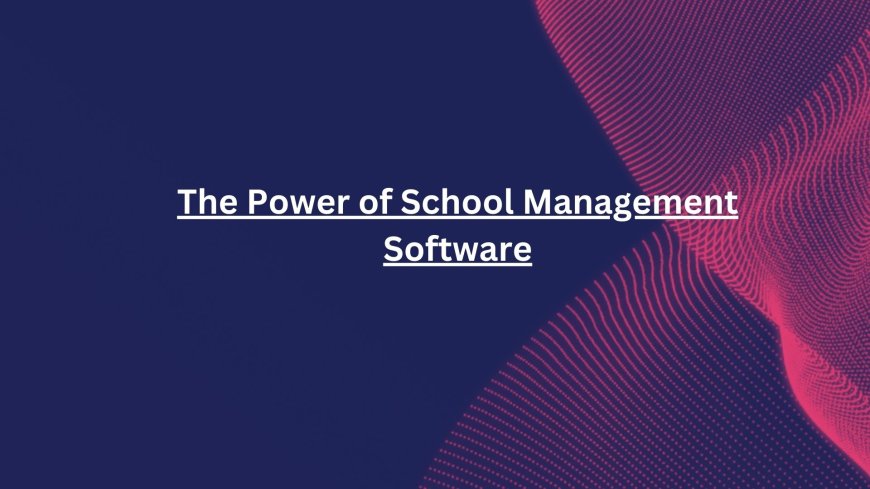The Power of School Management Software

In the fast-paced world of education, managing a school efficiently requires more than just dedication and hard work; it demands the integration of technology to streamline operations and enhance the learning experience. School Management Software (SMS) has emerged as a game-changer, providing comprehensive solutions to the myriad challenges faced by educational institutions. This blog explores the significance, features, and benefits of school management software, highlighting its role in transforming the educational landscape.
Understanding School Management Software
School Management Software is a robust, integrated platform designed to manage various administrative and academic tasks within an educational institution. From admissions and attendance to fee management and communication, SMS offers a centralized system to automate and simplify school operations.
Key Features of School Management Software
1. Student Information System (SIS)
- Comprehensive Records: Maintain detailed records of students, including personal information, academic history, and attendance.
- Real-Time Updates: Ensure that student data is always up-to-date and accessible to authorized personnel.
2. Attendance Management
- Automated Attendance: Track student attendance efficiently with automated systems, reducing manual errors.
- Attendance Reports: Generate detailed attendance reports for individual students, classes, or the entire school.
3. Timetable and Scheduling
- Class Scheduling: Create and manage class schedules, ensuring optimal use of resources and minimizing conflicts.
- Exam Scheduling: Plan and schedule exams with ease, ensuring smooth administration.
4. Fee Management
- Fee Collection: Automate fee collection and management, reducing administrative workload and ensuring timely payments.
- Financial Reports: Generate detailed financial reports to track income, expenses, and outstanding fees.
5. Communication Tools
- Parent-Teacher Communication: Facilitate seamless communication between parents and teachers through SMS, emails, and notifications.
- Internal Messaging: Enable staff and faculty to communicate effectively within the platform.
6. Academic Management
- Curriculum Management: Manage and update the school curriculum, ensuring alignment with educational standards.
- Gradebook: Maintain and update student grades, providing real-time access to academic performance.
7. Library Management
- Catalog Management: Maintain a digital catalog of library resources, including books, journals, and digital media.
- Issue and Return: Automate the issue and return process, reducing manual tracking and enhancing resource utilization.
8. Transport Management
- Route Planning: Plan and manage school transport routes, ensuring efficient and safe transportation of students.
- GPS Tracking: Provide real-time tracking of school buses, enhancing safety and communication with parents.
Benefits of Implementing School Management Software
1. Enhanced Efficiency and Productivity
- Automated Processes: Automating routine administrative tasks frees up time for staff and faculty to focus on more critical activities.
- Centralized Data Management: A centralized system ensures that all school data is accessible from a single platform, reducing redundancy and errors.
2. Improved Communication and Collaboration
- Seamless Communication: Facilitate better communication between teachers, parents, and students, fostering a supportive educational environment.
- Collaboration Tools: Enhance collaboration among staff and faculty, promoting a cohesive and efficient school operation.
3. Better Decision Making
- Data-Driven Insights: Access to real-time data and detailed reports enables school administrators to make informed decisions.
- Performance Tracking: Track academic and administrative performance, identifying areas for improvement and implementing corrective measures.
4. Enhanced Parent Engagement
- Parent Portal: Provide parents with access to a dedicated portal where they can monitor their child's progress, attendance, and communicate with teachers.
- Transparency: Increased transparency fosters trust and collaboration between parents and the school.
5. Cost and Resource Optimization
- Reduced Paperwork: Digital records and automated processes significantly reduce the need for paperwork, saving time and resources.
- Efficient Resource Utilization: Optimize the use of school resources, including staff, classrooms, and transport.
Choosing the Right School Management Software
When selecting a school management software, it’s essential to consider the specific needs and requirements of your institution. Here are some factors to keep in mind:
1. User-Friendliness
- Intuitive Interface: The software should have an easy-to-use interface that requires minimal training for staff and faculty.
- Accessible Support: Ensure the vendor provides comprehensive training and ongoing support to address any issues.
2. Customization and Scalability
- Tailored Solutions: Choose software that can be customized to meet the unique needs of your school.
- Scalable Platform: Ensure the software can scale as your institution grows, accommodating increasing data and user demands.
3. Integration Capabilities
- Seamless Integration: The software should integrate smoothly with other systems and tools used by the school, such as accounting software and learning management systems (LMS).
4. Security and Compliance
- Data Protection: The software must have robust security measures in place to protect sensitive student and staff data.
- Regulatory Compliance: Ensure the software complies with relevant educational regulations and standards.
Conclusion
School management software is transforming the way educational institutions operate, offering comprehensive solutions to streamline administrative tasks, enhance communication, and improve overall efficiency. By embracing this technology, schools can create a more organized, transparent, and supportive educational environment that benefits students, parents, and staff alike.
In the competitive landscape of education, adopting a robust school management system is not just a technological upgrade; it's a strategic move that can drive growth, enhance learning experiences, and foster a thriving school community. Invest in the right school management software and unlock the full potential of your educational institution.
What's Your Reaction?























